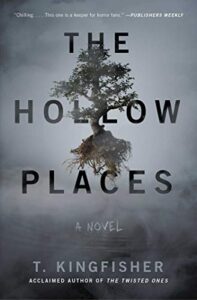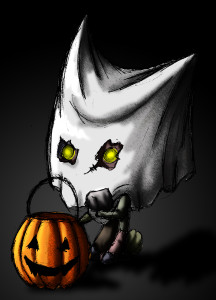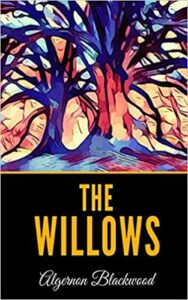A note from the editor:
We are midway through November and Monster Librarian still needs to raise the funds to pay for our hosting fees and postage in 2021. If you like what we’re doing, please take a moment to click on that red “Contribute” button in the sidebar to the right, to help us keep going! Even five dollars will get us closer to the $45 we still need to keep going at the most basic level. We have never accepted paid advertising so you can be guaranteed that our reviews are objective. We’ve been reviewing and supporting the horror community for 15 years now, help us make it another year! Thank you! And now our review of The Hollow Places: A Novel by T. Kingfisher.
The Hollow Places: A Novel by T. Kingfisher ( Bookshop.org | Amazon.com )
Gallery/Saga Press, 2020
ISBN-13 : 978-1534451124
Available: Paperback, Kindle edition, audio CD
T. Kingfisher is the pen name for Ursula Vernon, author of a webcomic and also the middle-grade Danny Dragonbreath books. In The Hollow Places, the author shows she can successfully and satisfyingly navigate from one genre and audience to another.
Recently divorced, Kara has moved into her uncle Earl’s combination museum/curiosity shop/living space and is cataloging his jumbled collection of objects and taxidermy while she figures out what to do with her life. While she’s there, a box of oddities arrives at the museum with a carving labeled “corpse otter” inside. When Earl hurts his knees badly enough that he’ll need major surgery, Kara takes over running the museum in his absence, and a few days later finds a mysterious hole in the drywall in the otter room, which showcases a giant taxidermied Amazonian otter and also displays the corpse otter carving.
Kara asks Simon, the quirky (and very gay) barista at the coffee shop next door, if he can help her patch the drywall. When Kara and Simon look through the hole, they see that it opens into a hallway that shouldn’t exist and decide to explore the hallway to see where it goes… that is, once they’ve packed flashlights, string, a tape measure, and a thermos of coffee. Both of them have seen enough horror movies to know not to split up, but not, apparently to leave locked doors alone, because they open the door at the end of the hallway to somewhere very like the Wood Between the Worlds in the Narnia books, except that instead of a wood filled with pools, it is a water world of islands swamped by willow bushes, each with a door to another world.
I had not read it before I read The Hollow Places, but at the end of the story, T. Kingfisher credits Algernon Blackwood’s The Willows as an inspiration for this book. As much as I could see the influence of C.S. Lewis, it is very clear that The Hollow Places, in setting and atmosphere, owes a great deal to Blackwood’s story. Kingfisher has taken elements from both authors and created something wholly original. Kara and Simon are both well-developed characters. It’s enjoyable to see them interact: they are sometimes snarky, often supportive, and protective of each other. They are funny and resourceful, and make a great team. The setting is almost a character itself: both the museum and the willow world with its many doors seem to have lives of their own. Without giving away the entire plot, I’ll just say you will never look at taxidermy the same way again.
The sense of creeping dread and the feeling that we are, as Kara puts it, just a pixel away from a hostile, alien dimension, is even more disturbing and compelling in Kingfisher’s book than it is in Blackwood’s story. While the plot doesn’t move along speedily, it has some great action sequences, especially near the end. Certainly it is worthy of consideration for a Stoker. Highly recommended.







Follow Us!